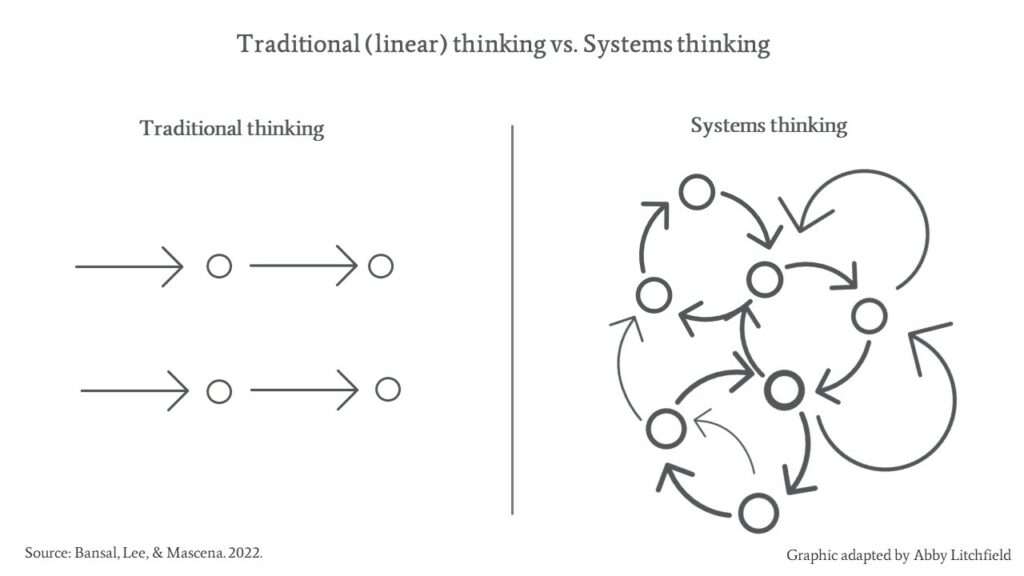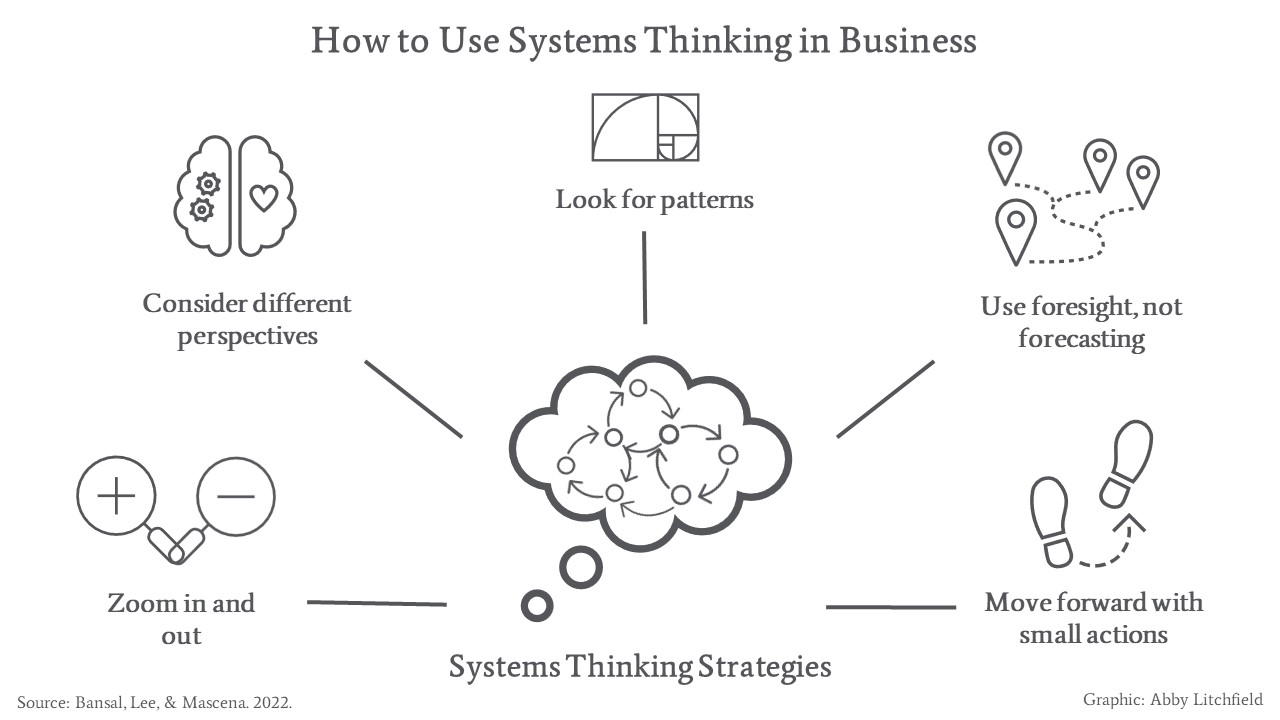Traditional, linear business thinking won’t solve social and environmental issues. Executives need systems thinking.
“The Basics” provides essential knowledge about core business sustainability topics.
Over 25 years ago, GM introduced the first electric vehicle, the “EV-1.” After producing the car from 1996 to 2003, GM terminated its production based on a narrow assessment of short-term profitability.
Although EV-1 had many technologies that are commonplace in today’s electric vehicles, GM sent all the cars to the crushers — despite protests from customers and environmental activists.
In recent years, the electric vehicle market has grown exponentially. Tesla, not GM, has been leading that growth. In 2021, Tesla’s market share in the U.S. electric vehicle market was a whopping 66%. GM’s was only 9%, despite belated aggressive investment. Now that GM has devoted itself to going all-electric by 2035, it will be fighting to gain the ground it lost.
If GM had used systems thinking in 2003, it might not have decided to discontinue the EV-1. Executives might have understood that broad changes in society would inevitably lead to demand for EVs. Those changes included increasing environmental concern, rising oil prices, and rapid improvements in technology.
Executives might have recognized EV-1 was not a bad product, but bad timing. They could have not just met market demands but helped shape them.
GM is not alone. Major global crises including climate change, pandemics, inequalities, polarization, and geopolitical tensions are making the business environment more complex and turbulent than ever before. That’s why many thought leaders see systems thinking as one of the most crucial management skills of the 21st century.
This article explains what systems thinking means, why it is important, and how companies can adopt it.
GM’s EV-1, Source: Detroit Free Press
The ideas in this article come from our work at Innovation North at Ivey Business School. At Innovation North, academic researchers work with leading companies and organizations in Canada to build a new corporate innovation process, based on systems thinking.
What Is Systems Thinking?
To understand systems thinking, we first need to know what systems are. Systems are interconnected elements, linked in ways that affect each other. That can sound complicated, but systems are all around us.
For example: Our bodies are made up of muscular, circulatory, and nervous systems. Each of us is also a part of many systems, including a team, an organization, an organization’s supply chain, and the financial markets. Similarly, each of us is part of a family, a community, a city, and a planet. These systems are nested in and overlap with other systems.
Because the elements in a system are connected, action in one area affects others. For example, connections in our global trade and transportation systems meant that a local virus originating in Wuhan, China in late 2019 took mere months to cause a global health crisis and trigger economic turbulence that would last for years.
Connections often lead to the ‘butterfly effect,’ where a small event somewhere in the world amplifies to something monumental. But it’s also possible for a major action to fizzle to nothing.
Systems thinking recognizes the existence of systems and considers them in decision making. With this approach, people can see the bigger picture and focus on the power of these connections. They’re better able to understand the world’s true complexity.
Systems thinking also reminds us that there is much we cannot see, much that is changing, much we cannot control, and much we cannot predict.
How Systems Thinking Is Different from Traditional Thinking and Why It is Valuable
While systems might seem obvious, companies and business schools have traditionally taken a simpler approach to strategy and decision-making — one that doesn’t reflect the real world. The figure shows the two approaches.

Traditional corporate decision-making is “analytical” or “reductionist.” That means it tries to break down a problem into smaller pieces and seek a single solution, rather than addressing systems. Using this approach, businesses will scope a decision narrowly, looking for simple cause-and-effect (linear) relationships. They also emphasize observations of the past – how things have worked before.
Look at microfinance, for example. A traditional approach to microfinance assumed that it could address poverty by extending financial services to individuals and organizations who wouldn’t otherwise have access to traditional banks.
But microfinance advocates didn’t consider how for-profit companies and other factors would change the industry. They had a narrow, “reductionist”, understanding of the problem. Now, many microfinance institutions ironically push people further into poverty and distress, through high interest rates and cruel collection practices. . “I felt terrible that microcredit took this wrong turn,” Muhammad Yunus, the originator of microfinance, recently told Bloomberg.
Systems thinkers understand that there are always multiple factors leading to a systems problem and clear cause-effect relationships are elusive. Because of this, there is rarely a single bullet – one best solution that solves everything.
Instead, systems thinkers look for underlying patterns. These can indicate the direction of future changes and help them see multiple solutions and opportunities.
Here are two concrete benefits of systems thinking in business: assessing unintended impacts accurately and better navigating systems risks, barriers, and opportunities.
1. Systems thinking can reduce unintended consequences
Many business activities create severe social and environmental consequences. Even progressive companies often end up disrupting local communities or adding plastic to landfills. Such harms to society and the environment undermine a company’s long-term success and sustainable development.
These outcomes can be unexpected, because decisions made in a linear way missed the big picture. Systems thinking allows companies to make that connection.
For instance: Airbnb’s business model around sharing economy was truly groundbreaking. It created an online community offering accommodation and local experiences to travelers. But it has also led to social problems, especially for local residents — housing shortages, higher rents, and hollowed-out communities. For example, in Barcelona, Airbnb is linked to a 45% drop in the number of local residents in the city’s Gothic Quarter during the past decade.
Airbnb’s strategic planning had a laser focus on the end user. But since customers tend to focus on their immediate interests, Airbnb didn’t see its impact on the wider context. While Airbnb met customer needs, it overlooked how its service might affect the communities it operates in.

Airbnb and gentrification in Barcelona, Source: Barcelona Laboratory for Urban Environmental Justice and Sustainability
2. Systems thinking can better navigate risks, barriers, and opportunities
Challenges and opportunities are more visible with systems thinking.
Remember the GM example? Had GM executives applied systems thinking, they could have seized the opportunity and become the market leader in a fast-growing market, instead of merely playing catch-up.
Or take the insurance sector as an example. Climate disasters like flooding and wildfires are increasing, taking a huge toll on property. An insurance company that doesn’t use systems thinking might focus solely on how climate change affects its current business. It might just price property insurance higher as risks go up.
If the insurance company thinks in systems, however, it will understand that climate change is intimately connected to its core business strategy. It will recognize that climate-related property damage will ultimately leave many people unable to insure.
Considering different perspectives and scenarios, it will broaden responses. Insuring the risks is not enough — it needs to think more about the “prevention” of the risk. For example, it might start rebuilding homes with “circular” or reused materials, in order to reduce environmental harm and potentially generate revenue.
How to Establish Systems Thinking in Companies
We suggest five core strategies for embedding systems thinking in your organizations.

1. Zoom out, not just in
When thinking about a problem or opportunity, start by zooming out on the wider context. What might happen at a longer time frame, or in another part of the world? Most organizations fail to account for climate change, for example, because they are consistently pushed to report their quarterly earnings. Climate change, by contrast, is large and slow-moving.
But you must also zoom in, to think about the finer points of processes and more immediate actions.
Keep zooming in and out. You want to see larger patterns, trends, and contextual factors as well as the details. Find out more about zooming out and in.
2. Consider different perspectives
Learning from people with different perspectives not only helps us see the bigger picture but also overcome biases and build creativity. It’s like the story of blind men discovering an elephant: One person sees only part of a system. Only different perspectives can complete the picture.
Whose perspective do you need? Traditionally, companies are told to focus on powerful and important stakeholders. But important insights come from perspectives that are often neglected, such as those of Indigenous people, future generations, and the natural environment.
For instance, Indigenous perspectives are essential in sustainability issues as they’re often more grounded ecologically and thus able to attend to subtle ecological cues.
3. Seek patterns, not cause-and-effect
Feedback loops in systems make it difficult to predict and control outcomes. Instead of simple cause-and-effect relationships, look for patterns that suggest the direction of future changes.
Patterns are the dynamics of a system caused by its underlying structure. For example: The COVID pandemic wasn’t an out-of-the-blue phenomenon, and it wasn’t the simple effect of one event. It was part of patterns, including increasing interaction between humans and wild animals and the resulting spread of viruses.
Systems thinkers like to use the metaphor of an iceberg. We see the iceberg’s tip, perhaps ramming a ship. But 90% of the iceberg’s mass is underwater, shaping ocean currents and the iceberg’s behavior at its tip. Pattern is the submerged mass, and awareness of it illuminates specific events.
When looking for patterns, note surprises or things that don’t seem to fit. These can contain important information about “underwater” systems and structures. For instance, Instagram’s success came from its founders’ attention to surprises. Working on their initially multifunctional social networking app, Burbn, they noticed lots of activity around image sharing. They decided to build a social networking app completely around the function. Find out more about looking for patterns.
4. Use foresight, not forecasting
Because outcomes are difficult to predict, the best approach is to consider multiple possible scenarios.
This approach is sometimes called “foresighting.” In keeping with systems thinking, foresighting “understands the future as an emerging entity that’s only partially visible in the present….The objective is not to ‘get the future right,’ but to understand a range of possible developments and scenarios” (Organization for Economic Development).
Foresighting differs from more traditional “forecasting,” which aims to chart a single path. Foresight is an ongoing approach, with continued monitoring, adaptation, and course correction.
5. Move forward with small actions
Executives can’t understand everything before acting. Taking small steps lets them learn more about the system by doing – from how the system reacts.
Systems thinking advocate Peter Senge explains this idea with the image of a dark room. He says that our complex world is like a dark room where people should move in baby steps.
This approach challenges the conventional idea of “fail fast, fail cheap.” Moving fast with big actions can cost a company and its stakeholders. Moving more cautiously, with numerous small probes, can reveal unknown risks and even new opportunities. You learn more about the system by observing how it reacts to your moves.
Applying Systems Thinking in Practice
Visit Innovation North to see how systems thinking can be applied to corporate innovation. Innovation North works with leading corporations and organizations in Canada to ‘innovate the innovation process.’ As organizations face greater complexity and disruption than ever before, they believe in revisiting our knowledge on innovation. For more up-to-date information about their new approach to innovation, click here.
About the Series
“The Basics” provides essential knowledge about core business sustainability topics. All articles are written or reviewed by an expert in the field. The Network for Business Sustainability builds these articles for business leaders thinking ahead.
About the Author
Dr. Ju Young Lee is a Postdoctoral Associate at the Center for Building Sustainable Value, Ivey Business School. He has completed his Ph.D. in Organization Studies at Boston College. His research interests include understanding the processes of systems changes, especially those that are aimed at addressing the grand societal challenges such as poverty, inequalities, and climate crisis. Ju Young is applying systems thinking to practice through Innovation North.
Review of this article was provided by Dr. Pratima (Tima) Bansal, Founder of the Network for Business Sustainability (www.nbs.net) and Professor of Strategy and Sustainability at the Ivey Business School (Canada).




Add a Comment
This site uses User Verification plugin to reduce spam. See how your comment data is processed.This site uses User Verification plugin to reduce spam. See how your comment data is processed.